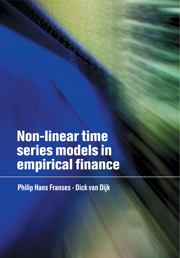2 - Some concepts in time series analysis
Published online by Cambridge University Press: 14 May 2010
Summary
In this chapter we discuss several concepts that are useful for the analysis of time series with linear models, while some of them can also fruitfully be applied to nonlinear time series. Examples of these concepts are autocorrelation functions, estimation, diagnostic measures, model selection and forecasting. After introducing the linear time series models which are of interest in section 2.1, we discuss these concepts in section 2.2 in the context of an empirical model specification strategy, to demonstrate how the various elements can be used in practice. In section 2.3 we demonstrate that linear time series models are less useful for out-of-sample forecasting of returns on stock indexes and exchange rates. Subsequent sections elaborate on concepts which are of special interest when dealing with economic time series – such as unit roots, seasonality and aberrant observations, first two being included for the sake of completeness.
As will become clear in later chapters, not all statistical tools which are commonly applied in linear time series analysis are useful in nonlinear time series analysis. However, as one often starts the analysis of empirical time series with linear models even if one is ultimately interested in nonlinear features, we feel that a basic knowledge and understanding of the most important concepts in linear time series analysis are indispensable. This chapter highlights only the main aspects. Readers interested in more detailed or advanced expositions may consult textbooks such as Box and Jenkins (1970); Anderson (1971); Granger and Newbold (1986); Mills (1990); Hamilton (1994); Fuller (1996); Brockwell and Davis (1997); and Franses (1998), among many others.
Information
- Type
- Chapter
- Information
- Non-Linear Time Series Models in Empirical Finance , pp. 20 - 68Publisher: Cambridge University PressPrint publication year: 2000
